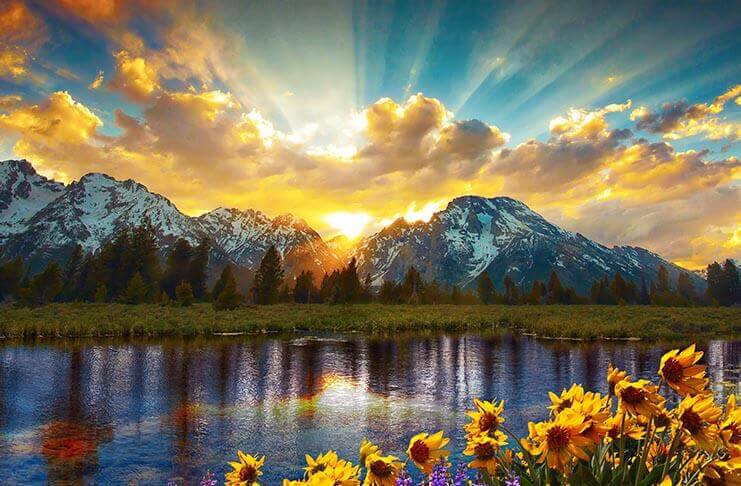Landscape photography is one of the most powerful visual genres in the world of photography. It captures the stunning essence of nature—majestic mountains, tranquil lakes, stormy skies, and golden deserts. With a single frame, you can tell a story of scale, emotion, and beauty. Whether you’re shooting in the wild or just outside your city, landscape photography invites you to slow down and observe your surroundings with intention.
Unlike portrait or product photography, where the subject is usually the focus, landscape photography relies heavily on composition, lighting, and natural elements. It’s about turning what’s already there into something visually poetic. With more people appreciating nature and travel, the demand for high-quality landscape photos continues to rise, especially across blogs, social media, and stock photography platforms.
Landscape photography focuses on capturing the beauty and vastness of outdoor scenes. These can be untouched natural environments or include elements like roads, architecture, or human presence—so long as the landscape remains the dominant theme. This genre aims to inspire viewers with the atmosphere, mood, and story of a place, not just its appearance.
It is different from still life photography or macro photography, where small subjects are arranged or closely observed. Instead, landscape photography is about going big—expansive skies, rolling hills, crashing waves, or forests drenched in mist. It’s about mood, light, and space, often requiring patience and a strong eye for detail.
To succeed in landscape photography, you’ll need more than just a good eye—you’ll need the right tools. The best camera for photography in this genre is usually a DSLR or mirrorless camera with high resolution and dynamic range. This allows you to capture the rich textures and colors found in nature. For those starting out, even advanced smartphones can be used effectively with the right techniques and settings.
Lenses play a critical role in framing the scene. Wide-angle lenses are ideal for showcasing the scale and depth of a landscape. A tripod is another essential, ensuring stability during long exposures or HDR shots. You may also need filters like ND (neutral density) and polarizers to manage reflections, reduce glare, and capture motion such as flowing water or moving clouds.

In landscape photography, composition is the heartbeat of a great image. One foundational rule is the rule of thirds, where the frame is divided into nine equal parts. Placing key elements—such as a mountain peak or tree line—along these lines creates balance and visual interest. Using natural lines like rivers, roads, or light patterns can lead the viewer’s eye through the photo.
Another important technique is timing. Shooting during golden hour—the hour after sunrise and before sunset—adds warm light and long shadows, enhancing depth and atmosphere. Blue hour, just before sunrise and after sunset, provides a cool, moody tone. These times bring out colors and textures that flat midday light often misses. Whether you’re capturing snow-covered peaks or sandy shores, light is your most powerful storytelling tool.
Practice makes perfect in landscape photography, but knowing a few professional tips can dramatically shorten the learning curve. First, always scout your locations. Use apps like PhotoPills or Google Earth to check the sun’s position, terrain, and access points. Arrive early and stay late to catch the best light and discover new compositions.
Second, weather is your creative partner. Don’t cancel your shoot because of fog or rain; these conditions can produce dramatic, moody images. A rainy forest, a foggy coastline, or a snow-dusted field can elevate your shots from simple to breathtaking. Think beyond blue skies—mood often creates more compelling photos than perfection.
Post-processing is a critical step in landscape photography. It helps correct minor issues and enhances the image without making it feel artificial. Start with basic adjustments like exposure, contrast, and white balance. Tools like Adobe Lightroom and Photoshop offer excellent features for controlling highlights, shadows, and color grading.
Color plays a huge role in how a landscape feels. A warm tone may convey peace, while cooler tones might evoke isolation or wonder. Just like in boudoir photography or black and white photography, editing should support the emotional tone of the image. Avoid over-processing; your goal is to enhance reality, not replace it.
A strong portfolio is your ticket to turning passion into profession. Showcase diverse environments—forests, oceans, deserts, and cities—with varying conditions like dawn, dusk, fog, or sunshine. Keep your editing style consistent to build a recognizable brand. Whether you’re interested in photography jobs or just want to grow your following, a clean and focused portfolio is essential.
There are several ways to monetize your landscape photography. Stock photography platforms allow you to sell digital downloads to bloggers, designers, and advertisers. You can also offer prints, calendars, or digital wallpapers. Many photographers also combine this work with portrait or real estate photography to diversify income and expand their client base.
While landscape photography is unique, it often overlaps with other styles. For instance, street photography might include cityscapes, while nature photography is closely tied to landscapes. Some photographers combine people with landscapes to tell more layered stories—think of little girl beach photography or couples walking through autumn woods.
Even if your main focus is landscape photography, exploring related styles like still life, macro, or nude photography can sharpen your eye. These genres improve your understanding of light, texture, and form, helping you see landscapes in new and creative ways. Cross-training in photography often unlocks unexpected artistic growth.
Landscape photography invites us to reconnect with nature, to explore new places, and to see familiar ones with fresh eyes. It requires technical knowledge, but also a deep sensitivity to mood, light, and story. Whether you’re on a mountain peak or in your own backyard, there’s always a frame worth capturing.
As you grow in your photography journey, remember that the best landscapes are not always the most exotic—they are the ones that stir emotion. Keep learning, keep shooting, and stay inspired. Landscape photography isn’t just about pretty pictures—it’s about seeing the world in ways others may miss.
- Landscape photography captures natural scenes with emotion and scale.
- Use wide-angle lenses, tripods, and the best camera for photography.
- Follow composition rules like the rule of thirds for balanced shots.
- Shoot during golden hour or in moody weather for dramatic images.
- Edit with care—enhance without overdoing.
- Build a portfolio and sell via stock photography or prints.
- Explore other genres to enhance your creativity and technique.
You may also read: Still Life Photography: Complete Guide with Tips, Ideas & Free Images

